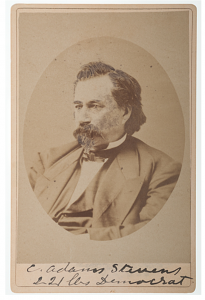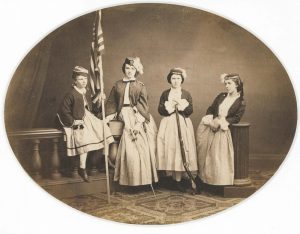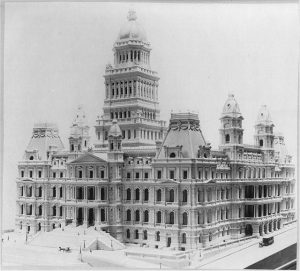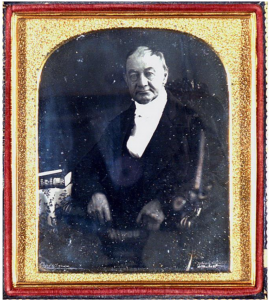
Our post yesterday had us curious about the photographer who may have noted the name of his subject (C. Adams Stevens), his political affiliation, and – and this is what we think least likely – his weight. The source for the photograph noted that on the back was the mark of one Rensselaer E. Churchill, and with a moniker like that, you’d think we could find more about this pioneering photographer.
Rensselaer Emmett Churchill was born about 1820 in a place called Fonda’s Bush in Montgomery County. Today we know it as Broadalbin. How he came down to Albany, and whether his first name was from a family connection or simply in honor of the patroon, we don’t know. It appears that he moved to Albany around the age of 10. He attended Albany Academy, at least in 1835, where he received certificates in proficiency in book-keeping, history of New York, and “Angus’ Exercises.” He married an Albany native named Gertrude Ramsay (the censuses seem to confuse Gertrude and Rachael, mother and daughter). They first appear together in 1855, living in a brick house in the city’s 4th ward, both aged 35. With them are six children ranging from 14 to 2, mother-in-law Ann Ramsay, and a 17-year-old Irish servant named Julia Kelley. At this time, he lists his occupation as “daguerreotyper.”
Daguerreotype was the first practical photographic process, and for many years the dominant one. Introduced in 1839, it involved copper plates and mercury vapor, creating an image on a mirror-like surface. Churchill appears to have been an early practitioner, who showed at the exhibits of the New York State Agricultural Society (today, we’d call it the State Fair) in 1850, and was awarded a medal in the “Paintings, Daugerreotypes, &c.” category for his “Daguerreotype specimens, scarcely inferior to those of Mr. Gavit, who received the first premium.” (D.E. Gavit also practiced his craft in Albany.)

He appears to have moved around a bit, and along the way he had a partner. In 1860, his office or studio is at 80 State Street, and his home at 189 Hudson Ave. Two years later he had moved his office to 82 State and was living at 34 Grand. In 1863, he had partnered up with Daniel Dennison (often spelled Denison), and their business was listed as photography at 522 Broadway. (Their ad for colored daguerreotypes can be seen here.) At some point they moved a door down to 520, and the two remained in business together at least through 1869. One of their attributed works is a well-known photograph of a group of women at the Sanitary Commission Fair held in Albany in 1864; Churchill & Dennison were the official photographers for the fair. (The U.S. Sanitary Commission was established by Mary Aston Livermore in 1863 as a civilian auxiliary organization dedicated to reform and raising funds to improve health conditions in military facilities.)
But in 1870, they had split up, Dennison moving to 13 North Pearl, and Churchill keeping the studio at 520 Broadway. His home was then at 30 Plain Street; by 1878, his home had moved to 144 Hudson. When he died of heart failure on May 25, 1892, his residence was 297 Madison Ave.
One would think a pioneering photographer working in the boomtown that Albany was at the time would have left more of an impression, but we find very little about him. Getty Museum seems to have an image of his, but it’s not available online. A handful of other references tease us, but produce nothing. The newspapers that are available mention his 1850 Agricultural Society participation, and the marriage of his son to a Chicago woman, but that’s it.
Churchill & Denison images regularly turn up on eBay and other auction sources. Their photographs of Ezra Cornell and Andrew Dickson White are featured on Cornell University’s founding page. The photographs of President Lincoln’s funeral procession and catafalque were also likely by the firm.
Thanks to Paula Lemire, you can see Rensselaer Churchill’s headstone from the Albany Rural Cemetery.



Leave a Reply